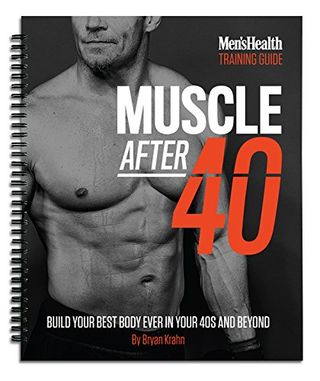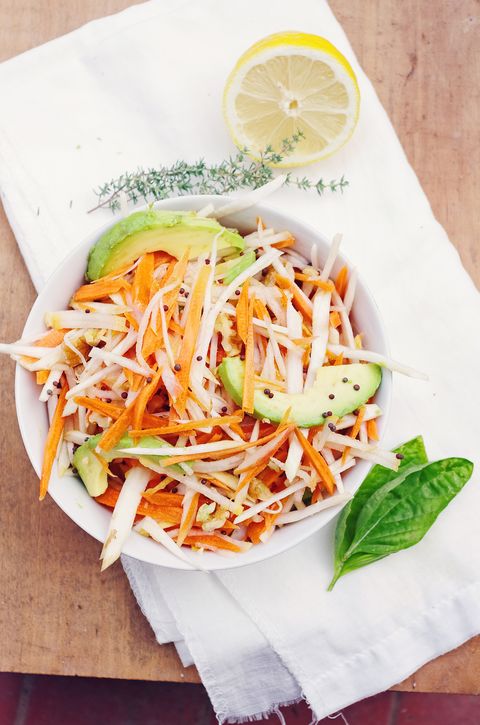If it seems like it’s become harder to lose weight since you hit age 50, you’re not imagining things. “As you age, your metabolism starts to slow down, and a lot of your metabolism functions and organs and absorption—everything just gets a little less efficient,” says Katherine L Tucker, Ph.D., professor of nutritional epidemiology and director of the Center for Population Health at the University of Massachusetts-Lowell. You now need fewer calories than ever just to maintain your body mass, let alone reduce it.
What’s more, as you age, the quality of muscle starts to change from being mostly muscle fibers to a combination of fat and muscle within the muscle fiber, says Stephen Anton, Ph.D., associate professor and chief of the Division of Clinical Research at the University of Florida College of Medicine’s Department of Aging and Geriatric Research. “After age 50, the process of your muscles being infiltrated by fat accelerates,” he says. The result? You may feel more easily fatigued. Your metabolism starts to slow down, and you lose muscle mass, making it harder to keep fat from piling on. In fact, a 50-year-old man requires about 100 fewer calories a day than a 20-year-old guy of the same weight, calculates Steven Heymsfield, M.D., of the Pennington Biomedical Research Center. “If you don’t compensate for that, then your weight will drift upward,” he says.
You can still lose weight after age 50 (and beyond)—but you will have to put in a more deliberate effort than you used to. Fortunately, there are some simple ways to shed the extra pounds.
1) Eat more fruits and vegetables
To lose weight, you obviously need to take in fewer calories than you expend. But instead of focusing on what to eat less of, let’s talk about what to eat more of. First up, fruits and vegetables. In a study from Harvard, people who increased their intake of fruits and vegetables lost weight, especially if they ate more berries, apples, pears, soy, or cauliflower. Fruits and vegetables are low in calories but rich in important vitamins and minerals you need more of as you age, including fiber, which can keep you full between meals, says Tucker. She recommends piling vegetables over half your plate at every meal. Keep frozen vegetables in your freezer so you never run out, and get creative with your salads by adding olives, cheese, or sliced oranges to make them more palatable. Check out our favorite breakfast salads—yes, breakfast salads—for more inspiration. Holly F. Lofton, M.D., director of the Medical Weight Management Program at NYU Langone Health, recommends “easy” vegetables: “Try ones you can just wash, cook, and eat, like asparagus and broccoli,” she says.
2) Buy an Instant Pot and make bean stews
Beans are packed with filling fiber and protein, and as they travel through your digestive system, their roughage and resistant starch feeds the good bacteria in your gut, says Tucker. These bacteria in turn create short-chain fatty acids, which are helpful in protecting your metabolism. A study review from Canada shows that people who ate a serving of legumes every day as part of a weight-loss effort lost a couple pounds in just an average of six weeks. Try making beans or lentils in an Instant Pot, which allows you to stew legumes with vegetables and other flavorful components and make enough for the whole family. Check out some more ways to make one of our favorite beans—the garbanzo.
3) Befriend your bathroom scale
Weigh yourself each morning so you notice right away if the number is trending up instead of down. “If you gain weight, and if you focus on it early and it’s only a few pounds, you can lose it quickly, but if you let it stay, basically it reprograms your body at a higher weight and it makes it hard to lose because you get hungry,” Tucker says. Especially if you want to lose weight over 50, it’s useful to jump on any gain right away. Learn more about the benefits of weighing yourself daily.
4) Focus on your food
Between your kids’ karate lessons, appointments with your accountant, and all the other obligations facing the modern 50-something man, you might not be giving your meals the respect they deserve. “People on the go tend to overeat,” says Bettina Mittendorfer, Ph.D., a research associate professor of medicine at Washington University in St. Louis, but eating slowly and mindfully can help your weight-loss efforts. Instead of eating in your car on the way to work or shoveling in lunch between meetings, plate your food, take a seat, and chew slowly so that you enjoy each bite. Adding crunchy elements to your meal, such as sliced jicama or cabbage, can also help you slow down and eat less. One more thing: See if the next episode of the hottest show on Netflix can wait until after dinner. (Hint: It can.) Eating in front of the TV is associated with weight gain, according to research published in the journal Obesity.
CreatiVegan.netGetty Images
Another danger zone for mindless eating is travel. Especially if you’re one of those people who eats when food is presented to you, says Dr. Lofton. “You might eat before the plane, on the plane, and after you land,” she says. Especially if there are a lot of business meetings over meals. She recommends that you have something easy that you eat once a day—even a meal replacement. “This creates some structure when you’re in situations where you don’t have as much control over meals,” she says.
5) Stop drinking sugar
Sugary foods and drinks fill you with calories—about 150 calories in a can of Pepsi, for example—but they don’t satisfy your appetite, which men over 50 undoubtedly have figured out by now. “A soda goes down quickly,” says Mittendorfer. “Eat the equivalent in a salad, and you’ll stay full longer.” (You’d have to eat more kale than you can stomach to hit 150 calories.) Among the benefits: People who stop drinking soda and other sugar-sweetened beverages gain less weight over time than those who do, a study review from Australia suggests. Even smoothies and juices can contribute lots of sugar to your body, Dr. Lofton points out. It’s better to have the whole fruit than just the juice.
6) Mix up your workouts

Get Ripped At Any Age
amazon.com
$24.95
Order Now
If you’ve been leaning on one type of exercise up to this point, now is the time to mix it up. In a recent study from the University of Illinois at Chicago and Iowa State University, older people who did a combination of 30 minutes of aerobic exercise and 30 minutes of resistance exercise three days per week reduced their body fat percentage and gained muscle. (They also showed improvements in blood pressure and cardiorespiratory fitness, important boosts to an aging heart.)
Resistance training is particularly effective in helping you build muscle, which burns more calories than fat, and aerobic training is particularly effective for helping you lose fat, says study author Elizabeth Schroeder, a doctoral candidate. “Together, they lead to a favorable body composition change and increasing strength and fitness with aging leads to a better quality of life and maintained independence,” she says.
For strength, “focus training on the legs and large muscle groups of the upper body with compound lifts, such as squats, deadlifts, bench press, and pull-ups,” Anton says. “These lifts engage more muscle groups then isolated lifts and typically lead to a greater increase in muscle gains while stimulating fat metabolism.” (And check out our resistance training for beginners.) For cardio, find something you enjoy, whether it’s running, cycling, swimming, or even walking.
(Check out the best cardio workouts that aren’t running.) Even better: Interval training, which combines periods of intense work followed by periods of lighter activity. If it’s been a while since you worked out, consult a personal trainer to assess your mobility so you know where to start.
7) Pick up a new sport
Playing pickup games with your buddies isn’t just fun: It’s like a powerhouse interval workout and therapy session all in one. “Sports such as soccer, basketball, and ultimate Frisbee would be ideal since [they] would burn lots of calories and the high intensity requirements lead to an increase in the amount of fat burned over the next 24 to 48 hours,” Anton says. The friendships you foster can help, too. “In general, that social support enhances people’s adherence to healthy lifestyle changes,” Anton says. In a study published in the Scandinavian Journal of Medicine & Science in Sports, people over 50 (they were between the ages of 55 and 70) who followed a weight-loss diet and played soccer shed more fat than those who followed the diet alone.
8) Try intermittent fasting
Intermittent fasting might sound intense, but it just means that you eat methodically during a certain period of the day instead of eating whenever you want. By restricting your food intake to certain hours of the day, you can encourage your body to shift from using glucose for energy to using ketones, which are derived from fat, Anton says.
You might start by just going eight or nine hours—including your sleeping hours—without eating. So from 8 p.m. to 6 a.m., you don’t eat. Simple enough, right? Then you can gradually train yourself to go 12 hours without food. “A few good male friends and family members who have practiced intermittent fasting have raved about the benefits in terms of reducing belly fat and improving energy levels,” Anton says. This type of eating pattern isn’t for everyone, so ask your doctor first.
MaskotGetty Images
9) Start a yoga practice
Yoga can help you enhance and maintain mobility when you’re over 50, and its calming effect can be beneficial when you’re trying to lose weight, Anton says. You probably won’t meet your weight loss goals with yoga alone, but it can be a helpful habit in tandem with others. Researchers in China found that older people who practiced yoga for a year shed about a centimeter off their waist circumference—a key marker of belly fat.
10) Check what you’re taking
“Many men over 50 are on some type of medication,” says Dr. Lofton. “It’s good to review the weight gain potential of medicines you are taking with your health care provider,” she says, if you feel you’re doing everything and still not losing. Sometimes, your meds can be changed to avoid that side effect.
11) Swap junky snacks for nuts
Make nuts your go-to snack, and you might fend off age-related weight creep, suggests recent research from Harvard. “What we observed was that on average adults tend to gradually gain weight over time,” said Deirdre K Tobias, Sc.D., an associate epidemiologist at Brigham and Women’s Hospital and an assistant professor at Harvard Medical School. “However, those who added nuts to their diet had less long-term gradual weight gain and were ultimately at a lower risk of developing obesity.” For every half serving of nuts people ate per day, they gained less weight over the next four years and had a lower risk of obesity over the next 20 to 24 years.
12) Opt for whole grains
Oats, barley, quinoa—they’re all good. In a Tufts University study, when people between ages 40 and 65 ate whole grains instead of refined grains such as white bread, they burned more calories and excreted more fat (yes, in their poop). Whole grains contain fiber, which promotes the growth of a diverse mix of bacteria in your gut, which may help your metabolism.
If you’re not in love with the flavor of whole grains, try different brands of whole grain bread, whole grain pasta, whole grain rice, and more until you find the right fit. “My best strategy for this is to eat the new food you want to learn to like when you are hungry, says study author Susan B. Roberts, Ph.D., Director of the Energy Metabolism Laboratory at the Jean Mayer USDA Human Nutrition Research Center on Aging at Tufts University. “You don’t have to eat huge amounts at first, but your hunger will accelerate changing taste preferences so that soon, the stronger taste is something you really enjoy.”
Source: Read Full Article

